This User Misses Space

This user misses space
-Mod Tohru
More Posts from Sidusglacies and Others


New from Tornado Titans!
@brettwrightphoto captured this cosmic looking supercell yesterday south of Andrews, TX. What would you do if this was coming at you? #txwx #UFO #weather #rain #rainyweather #storms #cloud #cloudporn #clouds #nature_lover #nature #nature_photo #nature_seeker #natgeoadventure #natgeoyourshot #natgeotravelpic #landscapes #landscapelover #epicsky #sky #skyporn #supercell #thunderstorm #storm #stormchasing #instaclouds #tv_clouds #ig_stormclouds #extremeweather https://instagr.am/p/CPnxoyzrnHJ/

i miss you all the time i miss you all the time

the truth is out there
Venus has LOCKED tectonic plates??? How does that work? How are they even counted as individual plates if it’s the tectonic equivalent of Pangea?
it's not so much that Venus's tectonic plates are locked, it's more that it never had them in the first place!
which is a major surprise, actually, because Venus is the most Earth-like of the other planets in our solar system.
surprise?

"what," you may say, flailing in consternation, "about Mars?? why are we trying to colonize Mars if Venus is more Earth-like???"
and it's a good question! Venus IS technically more Earth-like in the sense that it's right next door, is a solid 80% the size of Earth, and has both a working atmosphere and a liquid mantle composed of molten rock, BUT- it's also important to note that Venus is the hottest planet in the solar system and it rains boiling sulfuric acid at almost all times! our first probes to the damn place actually melted. MELTED.
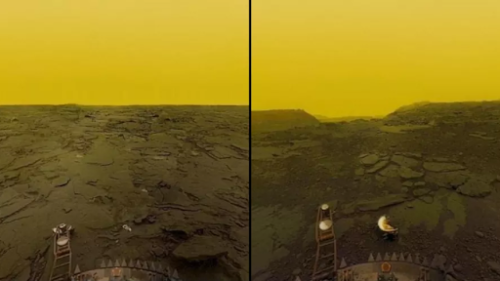
this is what Hell looks like.
BUT ANYWAY so Venus is the planet in our solar system that's the MOST physically similar to Earth, our dear mother who does not rain boiling sulfuric acid on our heads hardly at all ever, so it's kind of a shock that its geology is COMPLETELY FUCKING DIFFERENT.

see, Earth's outer crust is broken up into a series of mind-breakingly-massive tectonic plates that sort of skid around on top of the liquid mantle, slowly drifting in different directions driven by Earth's rotation and bonking into each other randomly like a 300-million-year-long Pinball tournament!
but on Venus, the entire outer crust is a single solid piece sitting on top of the liquid mantle, like the peel of an orange.

though not as good for you. because of the whole Boiling Acid thing.
and contrary to what you might think, this actually makes Venus a VERY VIOLENT place! the outer crust twists and deforms slightly as the liquid mantle spins under it, like a water balloon being flung repeatedly against a wall by a small child, but all of that force can't really be dispersed because the crust is a single solid piece of rigid rock!

so what happens is that this force builds and builds and BUILDS until Venus can't take the strain anymore and has a very volcanic tantrum about it.

unlike the rest of the solar system, the surface of Venus is made of relatively new and entirely volcanic rock- because the entire planet is basically having a planet-wide eruption event at all times, with multiple huge volcanos just spewing gigantic amounts of liquid rock everywhere like it's their damn job, to the point where Venus is just getting resurfaced like a McDonalds parking lot every epoch or so.
aren't you glad Earth doesn't do this? I am SO glad Earth doesn't do this.

(much, anyway)
uh anyway that's why we're trying to colonize Mars instead, and why plate tectonics are a GOOD thing! thanks for coming to my TED talk bye




Saturn and Neptune by Voyager II

Detroit Free Press, Michigan, August 31, 1934
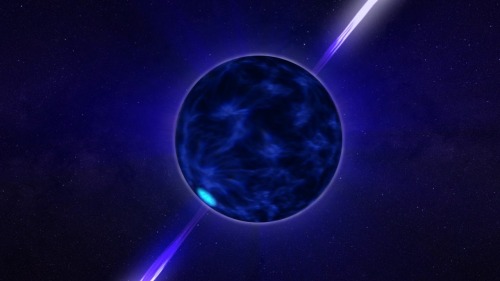
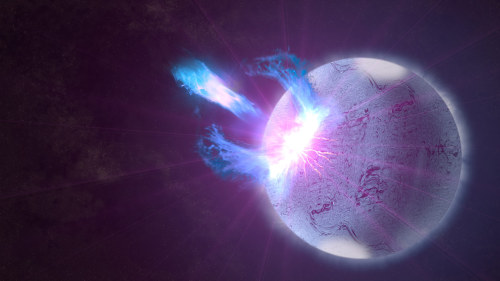
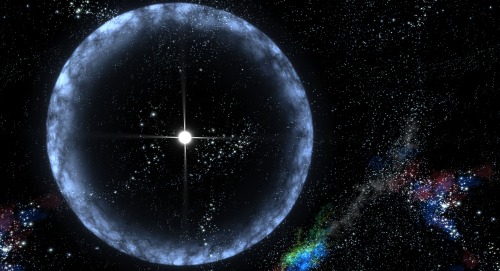
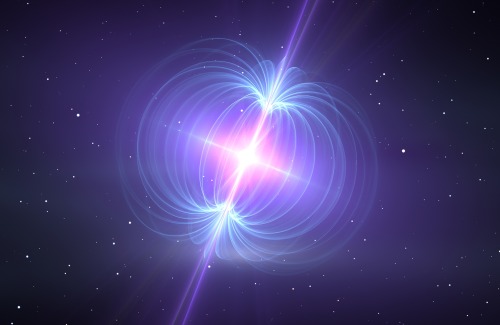
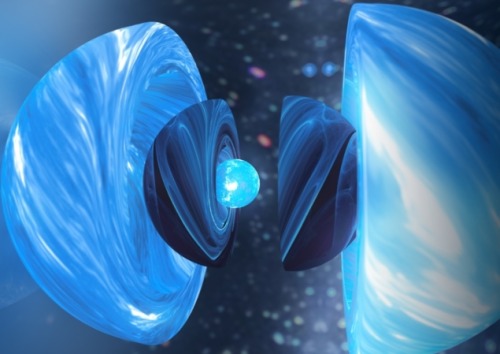
Starquakes
Sometimes a neutron star will undergo a glitch, a sudden small increase of its rotational speed or spin up. Glitches are thought to be the effect of a starquake—as the rotation of the neutron star slows, its shape becomes more spherical. Due to the stiffness of the “neutron” crust, this happens as discrete events when the crust ruptures, creating a starquake similar to earthquakes. After the starquake, the star will have a smaller equatorial radius, and because angular momentum is conserved, its rotational speed has increased.
Starquakes occurring in magnetars, with a resulting glitch, is the leading hypothesis for the gamma-ray sources known as soft gamma repeaters.
Recent work, however, suggests that a starquake would not release sufficient energy for a neutron star glitch; it has been suggested that glitches may instead be caused by transitions of vortices in the theoretical superfluid core of the neutron star from one metastable energy state to a lower one, thereby releasing energy that appears as an increase in the rotation rate. (source)









space goddess

-
 userbox-collector reblogged this · 4 months ago
userbox-collector reblogged this · 4 months ago -
 legendsoffandoms liked this · 10 months ago
legendsoffandoms liked this · 10 months ago -
 scarylilmonster liked this · 1 year ago
scarylilmonster liked this · 1 year ago -
 candieduranium liked this · 1 year ago
candieduranium liked this · 1 year ago -
 human-and-more reblogged this · 1 year ago
human-and-more reblogged this · 1 year ago -
 dragonic-wolf-soul reblogged this · 1 year ago
dragonic-wolf-soul reblogged this · 1 year ago -
 crypticnightmaress liked this · 1 year ago
crypticnightmaress liked this · 1 year ago -
 ittybitty-alien reblogged this · 1 year ago
ittybitty-alien reblogged this · 1 year ago -
 bramble-klawe liked this · 1 year ago
bramble-klawe liked this · 1 year ago -
 peculiar-alterbeing reblogged this · 1 year ago
peculiar-alterbeing reblogged this · 1 year ago -
 twstkinnie liked this · 2 years ago
twstkinnie liked this · 2 years ago -
 starzabove liked this · 2 years ago
starzabove liked this · 2 years ago -
 your-man-rage liked this · 2 years ago
your-man-rage liked this · 2 years ago -
 cherrypopbaybe liked this · 2 years ago
cherrypopbaybe liked this · 2 years ago -
 lakeofbl00d reblogged this · 2 years ago
lakeofbl00d reblogged this · 2 years ago -
 lakeofbl00d liked this · 2 years ago
lakeofbl00d liked this · 2 years ago -
 x3ph0s reblogged this · 2 years ago
x3ph0s reblogged this · 2 years ago -
 floyd-le liked this · 2 years ago
floyd-le liked this · 2 years ago -
 uficat liked this · 3 years ago
uficat liked this · 3 years ago -
 jasmiine-ann liked this · 3 years ago
jasmiine-ann liked this · 3 years ago -
 deep-within-my-soul reblogged this · 3 years ago
deep-within-my-soul reblogged this · 3 years ago -
 dogsncrackers reblogged this · 3 years ago
dogsncrackers reblogged this · 3 years ago -
 mallo-person liked this · 3 years ago
mallo-person liked this · 3 years ago -
 a-exists reblogged this · 3 years ago
a-exists reblogged this · 3 years ago -
 a-exists liked this · 3 years ago
a-exists liked this · 3 years ago -
 ssnotdripss liked this · 3 years ago
ssnotdripss liked this · 3 years ago -
 mourningthestars liked this · 3 years ago
mourningthestars liked this · 3 years ago -
 rae-iguess liked this · 3 years ago
rae-iguess liked this · 3 years ago -
 paulfanblog reblogged this · 4 years ago
paulfanblog reblogged this · 4 years ago -
 dreamingsydus liked this · 4 years ago
dreamingsydus liked this · 4 years ago -
 sweetstove liked this · 4 years ago
sweetstove liked this · 4 years ago -
 theodddogstuff liked this · 4 years ago
theodddogstuff liked this · 4 years ago -
 stinklebug liked this · 4 years ago
stinklebug liked this · 4 years ago -
 thecreator-atraitor liked this · 4 years ago
thecreator-atraitor liked this · 4 years ago -
 adhdnap liked this · 4 years ago
adhdnap liked this · 4 years ago -
 sexystrangersworld reblogged this · 4 years ago
sexystrangersworld reblogged this · 4 years ago -
 blueskido0 liked this · 4 years ago
blueskido0 liked this · 4 years ago
